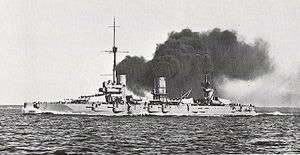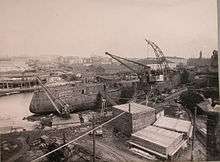Russian battleship Poltava (1911)
 | |
| History | |
|---|---|
| Name: | Poltava |
| Namesake: | Battle of Poltava |
| Operator: | Imperial Russian Navy |
| Builder: | Admiralty Shipyard, Saint Petersburg |
| Laid down: | 16 June 1909[Note 1] |
| Launched: | 23 July 1911 |
| In service: | 30 December 1914 |
| Name: | Frunze |
| Namesake: | Mikhail Frunze |
| Operator: | Soviet Navy |
| Acquired: | 1917 |
| Decommissioned: | October 1918 |
| Renamed: | 7 January 1926 |
| Struck: | 1 December 1940 |
| Fate: | Scrapped from 1949 |
| General characteristics | |
| Class and type: | Gangut-class battleship |
| Displacement: | 24,800 tonnes (24,400 long tons; 27,300 short tons) |
| Length: | 181.2 m (594 ft) |
| Beam: | 26.9 m (88 ft) |
| Draft: | 8.99 m (29.5 ft) |
| Propulsion: |
|
| Speed: | 24.1 knots (44.6 km/h; 27.7 mph) (on trials) |
| Range: | 3,200 nautical miles (5,900 km) at 10 knots (19 km/h; 12 mph) |
| Complement: | 1,149 |
| Armament: |
|
| Armor: |
|
Poltava (renamed Frunze in 1926) was the second of the Gangut-class battleships of the Imperial Russian Navy built before World War I. The Ganguts were the first class of Russian dreadnoughts. She was named after the Russian victory over Charles XII of Sweden in the Battle of Poltava in 1709. She was completed during the winter of 1914–15, but was not ready for combat until mid-1915. Her role was to defend the mouth of the Gulf of Finland against the Germans, who never tried to enter, so she spent her time training and providing cover for mine laying operations. She was laid up in 1918 for lack of trained crew and suffered a devastating fire the following year that almost gutted her. Many proposals were made to reconstruct or modernize her in different ways for the next twenty years, but none were carried out. While all this was being discussed she served as source of spare parts for her sister ships and was used as a barracks ship. She was finally struck from the Navy List in 1940 and scrapping began at a very leisurely rate. She was intentionally grounded in late 1941 to prevent her from being sunk in some inconvenient location by the Germans. She was refloated in 1944 and scrapped beginning in 1949.
Design

Poltava was 180 meters (590 ft) long at the waterline and 181.2 meters (594 ft) long overall. She had a beam of 26.9 meters (88 ft) and a draft of 8.99 meters (29.5 ft), 49 centimeters (1.61 ft) more than designed. Her displacement was 24,800 tonnes (24,400 long tons; 27,300 short tons) at load, over 1,500 t (1,500 long tons; 1,700 short tons) more than her designed displacement of 23,288 t (22,920 long tons; 25,671 short tons).[1]
Poltava's machinery was built by the Franco-Russian Works. Ten Parsons steam turbines drove the four propellers. The engine rooms were located between turrets three and four in three transverse compartments. The outer compartments each had a high-pressure ahead and reverse turbine for each wing propeller shaft. The central engine room had two each low-pressure ahead and astern turbines as well as two cruising turbines driving the two centre shafts. The engines had a total designed output of 42,000 shaft horsepower (31,319 kW), but they produced 52,000 shp (38,776 kW) during Poltava's full-speed trials on 21 November 1915 and gave a top speed of 24.1 knots (44.6 km/h; 27.7 mph). Twenty-five Yarrow Admiralty-type small-tube boilers provided steam to the engines at a designed working pressure of 17.5 standard atmospheres (1,770 kPa; 257 psi). Each boiler was fitted with Thornycroft oil sprayers for mixed oil/coal burning. They were arranged in two groups. The forward group consisted of two boiler rooms in front of the second turret, the foremost of which had three boilers while the second one had six. The rear group was between the second and third turrets and comprised two compartments, each with eight boilers. At full load she carried 1,847.5 long tons (1,877.1 t) of coal and 700 long tons (710 t) of fuel oil and that provided her a range of 3,500 nautical miles (6,500 km) at a speed of 10 knots (19 km/h).[2]
Her main armament consisted of a dozen Obukhovskii 12-inch (305 mm) Pattern 1907 52-calibre guns mounted in four triple turrets distributed the length of the ship. The Russians did not believe that super firing turrets offered any advantage as they discounted the value of axial fire and believed that super firing turrets could not fire while over the lower turret because of muzzle blast problems. They also believed that distributing the turrets, and their associated magazines, over the length of the ship improved the survivability of the ship. Sixteen 4.7-inch (119 mm) 50-caliber Pattern 1905 guns were mounted in casemates as the secondary battery intended to defend the ship against torpedo boats. She completed with only a single 3-inch (76 mm) 30-calibre Lender anti-aircraft (AA) gun mounted on the quarterdeck. Other anti-aircraft guns were probably added during the course of World War I, but details are lacking.[3] Conway's says that four 75-millimeter (3.0 in) were added to the roofs of the end turrets during the war.[4] Four 17.7-inch (450 mm) submerged torpedo tubes were mounted with three torpedoes for each tube.[3]
Service

Poltava was built by the Admiralty Shipyard at Saint Petersburg. She was laid down on 16 June 1909 and launched on 23 July 1911.[5] At the end of October 1914 she was struck by her sister Gangut which jammed her kedge anchor, damaged her hull and delayed her trials to late November 1914.[6] She entered service on 30 December 1914 when she reached Helsinki and was assigned to the First Battleship Brigade of the Baltic Fleet. However, gunnery and torpedo trials had to be postponed until mid-1915 because of the thick winter ice. She was the only ship of the class to perform a full-power speed trial, which she did in November 1915. She played a passive part in World War I as her role was to prevent the Germans from breaking into the Gulf of Finland, something the Germans never even tried. She ran aground in June 1916, but suffered little damage. Her crew participated in the February Revolution of 1917. She, and most of the Baltic Fleet, evacuated Helsingfors between 12 and 17 March 1918 despite the winter ice in the Gulf of Finland. Due to a shortage of crew she was placed into long-term conservation at Petrograd in October 1918.[5]
On 24 November 1919 a fire broke out in her forward boiler room and gutted much of her interior. She was henceforth used as a source of spare parts for her sisters. Along with the Borodino-class battlecruiser Izmail she was considered for conversion to an aircraft carrier in 1924 for service in the Black Sea, but this proved to be too ambitious and expensive given the state of the Soviet economy shortly after the end of the Russian Civil War. A more modest goal was to restore her to her original configuration and the Baltic Works actually began work in 1925, but exhausted the allotted funds on 15 February 1926 by which time she was estimated to be 46.5% complete. On 7 January 1926 she was given the name Frunze, after the recently deceased Bolshevik military leader Mikhail Frunze. Subsequent plans that focused on reconstructing her as a modernized equivalent to her sisters or even as a battlecruiser, with one turret deleted to save weight, were considered, but finally abandoned on 23 January 1935 when all work was stopped. Kliment Voroshilov approved one last plan to turn her into a floating battery, but the Baltic Works had no capacity to spare and this project was cancelled on 9 July 1939. During this period she was used as a barracks hulk while she was stripped for parts, until she was formally discarded 1 December 1940, after scrapping had already begun at a leisurely pace.[7] After the German invasion she was towed to Kronstadt and run aground late July 1941 near the Leningrad Sea Canal. During the Siege of Leningrad her hull was used as a base for small ships.[8] She raised on 31 May 1944, towed to Leningrad and scrapped beginning in 1949.[9]
After World War II two turrets and their guns were used to rebuild Coast Defence Battery 30 (Maksim Gor'kii I) in Sevastopol. It remained in service with the Soviet Navy through 1997.[10]
Notes
Footnotes
- ↑ McLaughlin, p. 207
- ↑ McLaughlin, pp. 208, 224–25
- 1 2 McLaughlin, pp. 220–21
- ↑ Gardiner & Gray, p. 303
- 1 2 McLaughlin, p. 227
- ↑ Цветков, И.Ф. Линкор Октябрьская Революция (in Russian). Leningrad: Ленинград "Судостроение". p. 107.
- ↑ McLaughlin, pp. 227, 348–54
- ↑ Цветков, И.Ф. Линкор Октябрьская Революция (in Russian). Leningrad: Ленинград "Судостроение". p. 190.
- ↑ McLaughlin, p. 354
- ↑ Wernet, Dieter; Wernet, Inge (1997). "Maksim Gor'kii I: A Recent Example of the Re-Use of Naval Turrets in Coast Defenses". Warship International. Toldedo, OH: International Naval Research Organization. XXXIV (1): 22–34. ISSN 0043-0374.
Bibliography
- Gardiner, Robert; Gray, Randal, eds. (1984). Conway's All the World's Fighting Ships: 1906-1922. Annapolis: Naval Institute Press. ISBN 0-85177-245-5.
- McLaughlin, Stephen (2003). Russian & Soviet Battleships. Annapolis, MD: Naval Institute Press. ISBN 1-55750-481-4.
External links
| Wikimedia Commons has media related to Battleship Poltava (1909). |
- World Battleships List
- Brief history plus photogallery (in Russian)